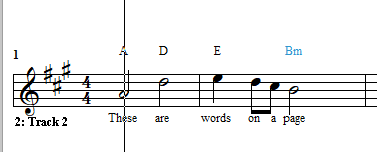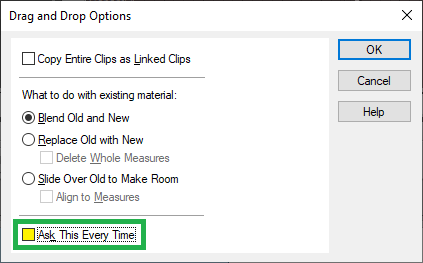-
Posts
6,067 -
Joined
-
Days Won
1
Everything posted by user905133
-
You missed the forest the first time. You are missing it here, too.
-
Maybe someone with more knowledge than me can clarify my admittedly vague memory, but I thought Staff View came when the sequencer was ported to Windows as an addition to Note View (which later became the PRV).
-
I spoke only for myself. I was not speaking for a collective "we" as you asserted. I was clear to point out that while the question was a good one, we (the users) are not decision-makers. That being said, I disagree with your interpretation and analysis of what I wrote. But quite honestly, it is not worth debating.
-
Not that I have any say in this as a Cakewalk user, but as an alternative I would rather see a monetary user investment system put into effect such that credit be given for the user financial support over the decades that led to the current product. Since this is purely a hypothetical issue over which users are not the financial decision-makers, let's say that CbB can be evaluated at a fair market value of $1200 (USD). As example 1, let's also say over the decades User A has paid $1500 over the decades, there would be no additional costs to continue to use Cakewalk by Bandlab. Let's say User B has paid $800 over the decades, a $400 "investment" in the software could be paid based on flexible terms, for example $10 / month for 40 months after which User B will have a "forever" license. Let's say User C is new to CbB. Perhaps after a 90 day trial to decide if User C wants to use it, she or he would have flexible terms (such as $10 / month) to continue to use it or discontinue both payments and use (classic rent-to-own licensing). Clearly this is a purely academic discussion. Let's be clear: we have no say in the matter. However, I think the question is a good one and if the decision-makers like your suggestion, I hope financial credit would be given to users who have helped financially support the software through years of purchases.
-
Let me see if I understand this. Are you saying someone without any IKM products can get MODO DRUM SE for $39.99 and then upgrade to MODO DRUM FULL for $199.99 instead of the current price of $299.99 for a savings of $60.00? If so, this seems to be more than someone who has a qualifying IKM product and just pays the $199.99 (a savings of $100.00) for MODO DRUM FULL. Are you saying that if the special offer request is accepted, someone who own Total Studio Max 2 could get MODO DRUMS FULL for an even greater savings? Thanks.
-

Can't get virtual instruments to record
user905133 replied to tleaustin's topic in Instruments & Effects
For the record, the method of using a mouse to record MIDI note data by pressing the black and white keys on a non-Cakewalk plug-in's virtual keyboard continues to work today. Likewise, it is still not very useful. I suppose if I ever need to simulate a note-quantized ribbon controller (either chromatic or white keys only) and want to record the MIDI note data, I might use this technique. ? Might be useful for psuedo-harp runs, too. Or, it might be useful for an experimental piece--perhaps generating note data for use with vocal samples from different sides of a highly popular, hotly contested political debate . . . .? Mouse Notes on a VST.pdf -
I just tried highlighting and moving a group of notes using the hold left-click method. I did not have to change the Drag and Drop Options setting. Do you need to use it (or can you just select and move the notes directly)? If not, uncheck "Ask Every Time."
-
This was my guess when I read your original posts yesterday. Thanks for taking the time and doing some tests, to msmcleod for the Manage Presets option, and for your follow-up explanations using that option. I started a project idea that never got implemented as planned for the Summer of 2020 (outdoor performances using indoor gear, including networked audio PCs) and this option might be very helpful if I implement it this summer or next. So, thanks for raising this issue here!
-
Very glad to hear this!!! I am not up to speed with using Bandlab-the-App, but I see great potential for the integration. Hope all the Cakewalk tutorial makers are keeping tabs on the possibilities for using Cakewalk and Bandlab together! I'm already fantasizing a personal Workspace (or other feature) that would allow me use Cakewalk and Bandlab assuming the deeper integration might translate into GUI elements and underlying functionality. (Yeah, I know its an extremely long-shot, but if you can make it happen, it might turn into a quantum leap.)
-
Not only that, but the C-64 had optional assembler software that could be used to write MIDI stuff (e.g., real time I/O code, on-the-fly data processing, MIDI file manipulation, etc.). It even had vector tables to tap into OS routines. For example, by re-routing the easy to use 60-times-per-second interrupt vector, incoming MIDI data could be very efficiently obtained, stored in a 256 byte circular buffer using zero-page write/read pointers, processed using arrays of pointers to various stages of the data processing routines, and then sent out. Predating Roli and MPE, the C-64 could channelize incoming single-channel midi data and process it, and send it out as repurposed multi-channel data. Not bad considering this was the mid-to-late 1980s using a 64kb computer with a 1 MHz (+/-) processor!!
-

Can't get virtual instruments to record
user905133 replied to tleaustin's topic in Instruments & Effects
Original post and updates withdrawn: Evidently my PC has an anomaly. At least one soft synth running within the current version of CbB can generate MIDI note data by playing the mouse in the plug-in's GUI. The note data shows up in the track, in staff view, in the event list, and even in the PRV. Somehow, the plug-in's keyboard functions as a virtual controller. In all probability, others are unlikely be able to duplicate this. In any case, as has been pointed out playing a plug-in's UI is not very efficient. -

Old USB 1.1 MK-425C midi keyboard?
user905133 replied to Pathfinder's topic in Instruments & Effects
My MK-249C works quite well in CbB under Windows 10. Sometimes I use the usb midi port, but I also have the 5-pin DIN output routed into a multi port midi interface. I have other keyboards too [including an MK-449C and an MK-461C] that I will connect as needed, but for several years the MK-249C has had a permanent space in front of my PC's keyboard. Not sure if it is USB1.1, though. I will look for the documentation. -
One possibility which I had when entering notes via a usb/midi keyboard: check to make sure only one midi input is routed to the track.
-
Not sure if you are aware of this or if it would be helpful to you, but the button sets for the Custom Module get saved and recalled in Workspaces.
-
I have used step recording modes on hardware (mainly Casio's CZ-5000). Shift+R brings up the floating panel in Cakewalk and works with Staff View and PRV. Not sure I will use it, but it is nice to know about this option. Thanks for asking about it and thanks to scook for linking the online documentation.
-
-
There is nothing innate here, it is based on a variety of factors including personal preferences, past experiences, familiarity. For example, this past year I found a software modular synthesizer that resonated with my early experiences using a Moog synthesizer. The software was easy for me to use because I had hands on experiences with the Moog. It has nothing to do with the software being innately intuitive or unintuitive. I understand frustrations when trying to learn or do something new, something unfamiliar. However saying X is innately more intuitive or Y is innately unintuitive is counterproductive to buckling down and tackling a learning curve. Why not just admit that something is new to you, has a different workflow, is unfamiliar to you, etc. and on that basis you are struggling with the learning curve? For example, there is another DAW which some people like. I have tried to use it without success in large part because all of the visual and functional elements are very unfamiliar to me. They are not the same as other DAWs I have used. But, it is not innately unintuitive. If I wanted to re-learn what I already know how to do in other software, I am empowered because I know why I find it difficult to use and can (if I choose) overcome those obstacles.
-
Also, have you tested the midi out from the piano with a third party program (such as midi-ox) to make sure the data is being sent out properly? Assuming note data and CCs are coming from the piano, is it possible you have it set up as a control surface that prevents note data and CCs from getting to the soft synth?
-
They do not do the same thing. To me they serve very different purposes, though both do have save and recall functionality. There are many threads/posts that address the differences. If someone else doesn't post links to those threads/posts, I'll see if I can compile a list.
-
-
Footnote: About a month ago there was a Humble Bundle that included (I think it was approx. 20 USD) included updated, non-SONAR Editions of these three AAS products plus other products all of which are not limited to SONAR/CbB.
-

Clicks and dropouts on new rig
user905133 replied to David Grammerstorf's topic in Cakewalk by BandLab
With new activity in this thread, I decided to update latency mon (from 6.71 home to 7.00 home). Today, LatencyMon was squarely in the red from the start unlike previously plus I have the wdf01000.sys issue. It could be coincidence, but after some Windows Updates over the past month or two I have noticed System interrupts using increasingly more of my CPU. I have needed to adjust settings and pay closer attention to CPU load to avoid driving the CPU above the level that interferes with audio (pops, crackles, distortion, etc.) I haven't yet gotten to explore what is causing the increased System interrupts load. Prior to today: "Your system appears to be suitable for handling real-time audio and other tasks without dropouts. LatencyMon has been analyzing your system for 0:15:00 (h:mm:ss) on all processors." Today: "Your system seems to be having difficulty handling real-time audio and other tasks. You may experience drop outs, clicks or pops due to buffer underruns. One or more DPC routines that belong to a driver running in your system appear to be executing for too long. One problem may be related to power management, disable CPU throttling settings in Control Panel and BIOS setup. Check for BIOS updates. LatencyMon has been analyzing your system for 0:16:02 (h:mm:ss) on all processors."







